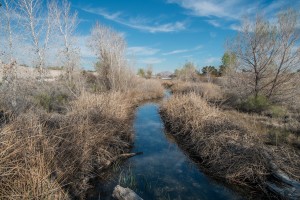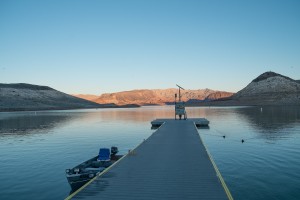LAS VEGAS – I like the fact that Las Vegas, Nev., is preserving the relics of its water origin story.
From “spring hill” at the Springs Preserve municipal park, you can see the towers of Las Vegas’s gambling strip. Visitation at the park this afternoon when I snuck away for a bird-watching walk after a morning of meetings downtown was no match for the crowds around the Bellagio’s more famous water treatment. But it’s a lovely park, with walking trails that wind among the sites of the old springs around which the first incarnation of modern Las Vegas was founded more than a century ago.
I saw verdin, lovely little yellow-gray birds with remarkable adaptations to desert life, and flickers playing on the telephone poles.
I guess every city is defined by its relationship with its water, but Las Vegas is perhaps more so? The modern city grew around the springs that are now preserved at the park, which provided a water supply for the railroad’s construction and the town site that grew around the tracks. Artesian wells eventually were drilled all across the central valley, until the artesian flow stopped, then groundwater pumping followed.
The modern Las Vegas water story dates to the 1930s, when construction of Hoover Dam nearby drove a population boom (construction workers) and a tourist boom (folks driving up from L.A. to watch the construction). And it created a vast reservoir that borders to the Las Vegas metro area to the east. Lake Mead is both playground to and water supply for Las Vegas and the population boom that followed, long replacing an aquifer ill-suited to a city of 2 million.
Mead also has become a nervous reminder, to folks in Vegas who pay attention, of the fragile nature of life in the desert. A guy named Scotty, a 40-something who works in the Vegas convention industry, explained that nervous feeling as we chatted yesterday afternoon while he pulled his little aluminum Jon boat onto a trailer after an early fishing season scouting trip out of Boulder Harbor.
He moved here in 1997, and can remember when the reservoir was so full kids could drive out the dirt road along Gypsum Wash east of town to a spot where they could take eight foot dives off a little cliff into the lake. Today, it’s an 80 foot cliff with a sandy wash at the bottom as a landing spot. Mead’s surface elevation is 107 feet down from the year Scotty arrived, and watching the change – he’s out here fishing or boating the lake nearly every week, he said – makes him wonder whether Vegas will eventually just dry up and blow away.
My conversations with the region’s water managers suggests that’s unlikely. But the visibility of the white bathtub ring around Lake Mead’s shoreline – it’s just a 30-mile drive from the Bellagio to Boulder Harbor – provides a fascinating visual reminder of the drought that few bit western cities.
It’s easy to make misleading connections here. Water use in Las Vegas has little to do with Lake Mead’s big empty. As I’ve written before, Las Vegas is one of the few water users on Lower Colorado River taking less then its full entitlement from Lake Mead, and what it is taking is far less than the big ag users downstream. But there’s also no way to avoid the unusually tight connection between this community and its water, which stretches in an unbroken historical line from the springs to Lake Mead. It’s what makes Vegas so interesting a story-telling water nerd.


